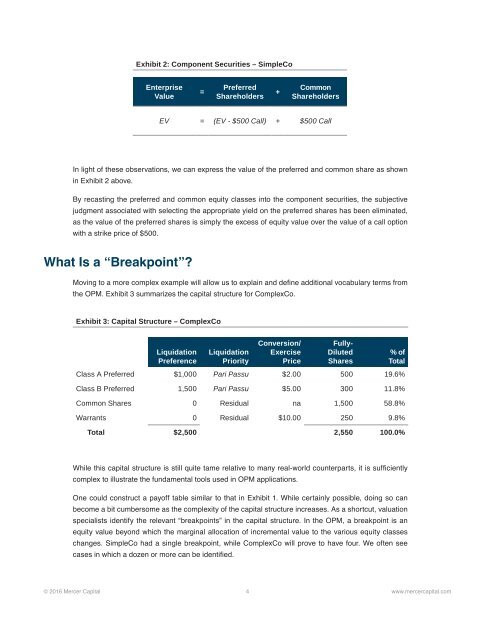A Layperson’s Guide to the Option Pricing Model
Article_Mercer-Capital-Guide-Option-Pricing-Model
Article_Mercer-Capital-Guide-Option-Pricing-Model
Create successful ePaper yourself
Turn your PDF publications into a flip-book with our unique Google optimized e-Paper software.
Exhibit 2: Component Securities – SimpleCo<br />
Enterprise<br />
Value<br />
=<br />
Preferred<br />
Shareholders<br />
+<br />
Common<br />
Shareholders<br />
EV = (EV - $500 Call) + $500 Call<br />
In light of <strong>the</strong>se observations, we can express <strong>the</strong> value of <strong>the</strong> preferred and common share as shown<br />
in Exhibit 2 above.<br />
By recasting <strong>the</strong> preferred and common equity classes in<strong>to</strong> <strong>the</strong> component securities, <strong>the</strong> subjective<br />
judgment associated with selecting <strong>the</strong> appropriate yield on <strong>the</strong> preferred shares has been eliminated,<br />
as <strong>the</strong> value of <strong>the</strong> preferred shares is simply <strong>the</strong> excess of equity value over <strong>the</strong> value of a call option<br />
with a strike price of $500.<br />
What Is a “Breakpoint”?<br />
Moving <strong>to</strong> a more complex example will allow us <strong>to</strong> explain and define additional vocabulary terms from<br />
<strong>the</strong> OPM. Exhibit 3 summarizes <strong>the</strong> capital structure for ComplexCo.<br />
Exhibit 3: Capital Structure – ComplexCo<br />
Liquidation<br />
Preference<br />
Liquidation<br />
Priority<br />
Conversion/<br />
Exercise<br />
Price<br />
Fully-<br />
Diluted<br />
Shares<br />
% of<br />
Total<br />
Class A Preferred $1,000 Pari Passu $2.00 500 19.6%<br />
Class B Preferred 1,500 Pari Passu $5.00 300 11.8%<br />
Common Shares 0 Residual na 1,500 58.8%<br />
Warrants 0 Residual $10.00 250 9.8%<br />
Total $2,500 2,550 100.0%<br />
While this capital structure is still quite tame relative <strong>to</strong> many real-world counterparts, it is sufficiently<br />
complex <strong>to</strong> illustrate <strong>the</strong> fundamental <strong>to</strong>ols used in OPM applications.<br />
One could construct a payoff table similar <strong>to</strong> that in Exhibit 1. While certainly possible, doing so can<br />
become a bit cumbersome as <strong>the</strong> complexity of <strong>the</strong> capital structure increases. As a shortcut, valuation<br />
specialists identify <strong>the</strong> relevant “breakpoints” in <strong>the</strong> capital structure. In <strong>the</strong> OPM, a breakpoint is an<br />
equity value beyond which <strong>the</strong> marginal allocation of incremental value <strong>to</strong> <strong>the</strong> various equity classes<br />
changes. SimpleCo had a single breakpoint, while ComplexCo will prove <strong>to</strong> have four. We often see<br />
cases in which a dozen or more can be identified.<br />
© 2016 Mercer Capital 4 www.mercercapital.com


